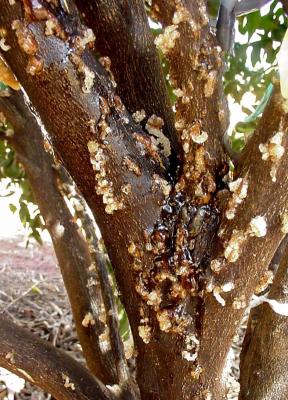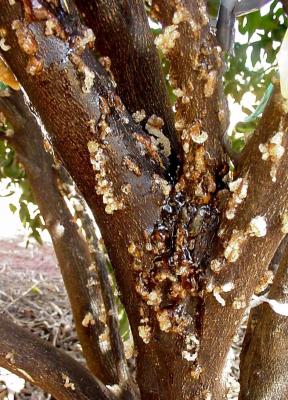

Phytophthora-induced diseases (Phytophthora spp.)
They cause the most serious soil-borne diseases of citrus. These fungi are worldwide in distribution and cause citrus production losses in irrigated, arid areas as well as in areas with high rainfall. Diseases caused by Phytophthora spp. include damping-off in seedbeds, gummosis and brown rot of fruits. The most widespread and important Phytophthora spp. are P. nicotianae and P. citrophthora. Others of lesser importance in the tropics are P. citricola, P. hibernalisand P. palmivora. The most serious disease caused by Phytophthora spp. is gummosis (also known as foot rot).
Gummosis: An early symptom of gummosis is gum oozing from small cracks in the infected bark around the bud-union giving the affected trees a bleeding appearance. Citrus gum, which is water soluble, disappears after heavy rains. Severely affected tress have yellow foliage that eventually drops and twigs die-back often with a crop of small-sized fruits still hanging from bare branches. The feeder roots are destroyed when the root cortex is attacked; turn soft and easily separate giving the root system a stringy appearance. In an advanced stage, the trunk becomes girdled (encircled) and the affected trees decline and eventually die.
Gummosis is favoured by high moisture in the soil. Infection of fruit by Phytophthora spp. produces brown rot. The affected area is light brown, leathery and not sunken compared with the adjacent rind. Under humid conditions, white fungal growth (mycelium) forms on the rind surface. In the orchard, fruits on or near the ground become infected when they are splashed with water or come in contact with soil that is infested by Phytophthora spp.
Most of the infected fruits drop, but those that are harvested may not show symptoms until after they have been held in storage for a few days. Brown rot epidemics are usually restricted to areas where rainfall coincides with early stages of fruit maturity. It is important to note that most Phytophthora spp. are seed-borne.
- Treat citrus seeds with hot water at 50°C for 10 minutes (just too warm to keep a finger in for any amount of time)
- Soil drenches of copper based fungicide (allowed under organic farming in East Africa) are useful in preventing Phytophthora diseases in the nursery.
- Use tolerant or resistant rootstocks. Trifoliate orange is resistant. Swingle citrumelo, sour orange, rough lemon, and citranges (Carrizo and Troyer) are tolerant.
- Bud seedlings at a height of 25 cm and above, which will keep the bud union well above ground level.
- Avoid transplanting on heavy or poorly drained soils.
- Do not heap soil around the tree base.
- Avoid basin and flood irrigation. Do not over irrigate and ensure water does not contact the bud union.
- Avoid injuries to roots and trunks when cultivating.
- Gummosis can be halted by bark surgery before 50% of the trunk is affected. Scrape away dead bark tissue, remove about 10 mm margin of healthy tissue and paint the wound with a slurry of copper-based fungicide (allowed under organic production) or under non-organic production with metalaxyl or fosetyl-Al.
- Do not replant citrus into planting sites where other citrus has been grown and proven unhealthy.
